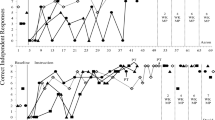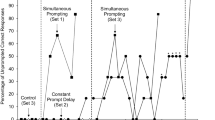Abstract
Two methods of prompting were compared for their relative effectiveness in teaching a group of autistic students to discriminate line drawings used in picture communication books. All four students required fewer trials to meet the task criterion using a delayed-prompting technique. Further, students made significantly more errors in the fading-of-prompts design than in the delayed-prompting design. The high rate of errors in faded-prompt sessions resulted in some students displaying aberrant behaviors. The results are discussed in terms of effectiveness of the two teaching methodologies, as well as the consequences of error patterns. Suggestions are made for further research.
Similar content being viewed by others
References
Baer, D., & Guess, D. (1973). Teaching productive noun suffixes to severely retarded children.American Journal of Mental Deficiency, 77, 498–505.
Bennett, D., Gast, D., Wolery, M., & Schuster, J. (1986). Time delay and system of least prompts: A comparison in teaching manual sign production.Education and Training of the Mentally Retarded, 21, 117–137.
Billingsley, F., & Romer, L. (1983). Response prompting and the transfer of stimulus control: Methods, research, and a conceptual framework.TASH Journal, 8, 3–12.
Blackstone, S., & Bruskin, D. (1986).Augmentative communication: An introduction. Rockville, MD: American Speech-Language-Hearing Association.
Browder, D., Morris, W., & Snell, M. (1981). Using time delay to teach manual signs to a severely retarded student.Education and Training of the Mentally Retarded, 16, 252–258.
Bullock, A., Dalrymple, G., & Danca, J. (1975). Communication and the nonverbal handicapped child.American Journal of Occupational Therapy, 29, 150–152.
Carr, E., & Durand, M. (1985). Reducing behavior problems through functional communication training.Journal of Applied Behavior Analysis, 18, 111–126.
Csapo, M. (1981). Comparison of two prompt procedures to increase response fluency among severely handicapped learners.TASH Journal, 6, 39–47.
Dyer, K., Christian, W., & Luce, S. (1982). The role of response delay in improving the discrimination performance of autistic children.Journal of Applied Behavior Analysis, 15, 231–240.
Fristoe, M., & Lloyd, L. L. (1978). A survey of the use of nonspeech communication systems with severely communication impaired.Mental Retardation, 16, 99–103.
Gast, D., & Issac, G. (1978).Teaching multiply handicapped children object naming using a time delay procedure. Paper presented at the Fifth Annual Conference of the American Association for the Education of the Severely and Profoundly Handicapped, Baltimore.
Gast, D., & Issac, G. (1979).Teaching nonverbal multiply handicapped children object labeling using time delay procedure. Paper presented at the Sixth Annual Conference of the American Association for the Education of the Severely and Profoundly Handicapped, Chicago.
Godby, S., Gast, D., & Wolery, M. (1987). A comparison of time delay and system of least prompts in teaching object identification.Research in Developmental Disabilities, 8, 283–306.
Gold, M., & Scott, K. (1971).Training the developmentally young (W. Stephens, Ed.), New York: John Day.
Halle, J., Marshall, G., & Spradlin, J. (1979). Time delay: A technique to increase language useage and facilitate generalization in retarded children.Journal of Applied Behavior Analysis, 12, 431–439.
Johnson, C. (1977). Errorless learning in a multihandicapped adolescent.Education and Treatment of Children, 1, 25–33.
Kiernan, C. (1983). The use of nonvocal communication techniques with autistic individuals.Journal of Child Psychology and Psychiatry, 24, 339–375.
Kleinen, H. L., & Gast, D. L. (1982). Teaching a multihandicapped adult manual signs using a constant time delay procedure.TASH Journal, 6(4), 25–32.
Mayer-Johnson, R. (1985).The picture communication symbols. Solana, CA: Mayer-Johnson.
McReynolds, L., & Kearns, K. (1983).Single subject experimental designs in communicative disorders. Baltimore: University Park Press.
Musselwhite, C., & St. Louis, K. (1982).Communication programming for the severely handicapped. San Diego: College Hill Press.
Oliver, C., & Halle, J. (1982). Language training in the everyday environment.TASH Journal, 8, 50–62.
Reid, D., & Hurlbut, B. (1977). Teaching nonvocal communication skills to multiply handicapped retarded adults.Journal of Applied Behavior Analysis, 10, 591–603.
Renzaglia, A., & Snell, M. E. (1981).Manual sign training for the severely handicapped: Time delay and a system of least prompts. Unpublished manuscript.
Shane, H., & Bashir, A. (1980). Election criteria for the adoption of an augmentative communication system.Journal of Speech and Hearing Disorders, 45, 408–415.
Sidman, M., & Stoddard, L. (Eds.). (1966).International review of research in mental retardation (pp. 151–208). New York: Academic Press.
Smeets, P. M., & Streifel, S. (1976). Acquisition and cross-modal generalization of receptive and expressive signing skills in a retarded girl.Journal of Mental Deficiency Research, 20, 251–260.
Snell, M., & Gast, D. (1981). Applying time delay procedures to the instruction of the severity handicapped.TASH Journal, 6, 3–15.
Striefel, S. (1974).Managing behavior—behavior modification: Teaching a child to imitate (Part 7). Lawrence, KS: H & H Enterprises.
Streifel, S., Wetherby, B., & Karlan, G. (1976). Establishing generalized verb-noun instruction following skills in retarded children.Journal of Experimental Child Psychology, 22, 247–260.
]Stremmel-Campbell, K., Cantrell, D., & Halle, J. (1977). Manual signing as a language system and as a speech initiator for the non-verbal severely handicapped student.In Educational Programming for the Severely/Profoundly Handicapped (pp. 335–347). Reston, VA: Council for Exceptional Children.
Touchette, P. (1968). The effects of graduated stimulus change on the acquisition of a simple discrimination in severely retarded boys.Journal of the Experimental Analysis of Behavior, 11, 39–48.
Touchette, P., & Howard, J. (1984). Errorless learning: Reinforcement contingencies and stimulus control transfer in delayed prompting.Journal of Applied Behavior Analysis, 17, 175–188.
Vanderheiden, D., Brown, W., MacKenzie, P., Reinen, S., & Scheibel, C. (1975). Symbol communication for the mentally handicapped.Mental Retardation, 13, 34–37.
Weeks, M., & Gaylord-Ross, R. (1981). Task Difficulty and aberrant behavior in severely handicapped students.Journal of Applied Behavior Analysis, 14, 449–463.
Zeaman, D. (1965).The biosocial basis of mental retardation. Baltimore: Johns Hopkins Press.
Author information
Authors and Affiliations
Rights and permissions
About this article
Cite this article
Berkowitz, S. A comparison of two methods of prompting in training discrimination of communication book pictures by autistic students. J Autism Dev Disord 20, 255–262 (1990). https://doi.org/10.1007/BF02284722
Issue Date:
DOI: https://doi.org/10.1007/BF02284722




